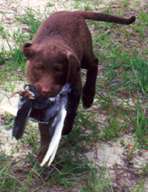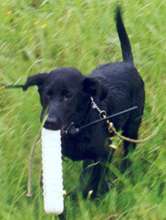



|
|
 |
||
 |
|
|
|
Introducing Puppies to Birds, Water, and Throwers by John and Amy Dahl First Published by Tri-Tronics, June 1999 Birds, throwers, and water are all features of retrieving work which are best introduced while a retriever is still a pup, impressionable and flexible in its thinking. As with all puppy work, the most effective approach is to set up the circumstances so the puppy is likely to get it right. Success leads to rapid learning as well as promoting confidence. If your puppy responds "wrong," i.e., in a way you don’t want it to, keep your temper – and plan the next session so that it won’t include a temptation to that behavior. With more mature dogs, we sometimes make a point by setting up a temptation and then correcting the dog for giving in, but this is inappropriate for puppies. Remember – the most important goal of puppy work is to build desire by making retrieving enjoyable for your pup. Starting your pup on birds before the age of six months is desirable, as after that age some dogs seem to lose the capacity to become really birdy. We like to use a freshly-killed pigeon. Tease the pup with the bird and toss it, as when you were first teaching your pup to retrieve. Resist the temptation to sing out encouragement as your puppy approaches and sniffs the bird; you will only distract it. Praise, cheer, clap, etc., only after your pup has picked up the bird. If, after sniffing the bird for a little while (maybe 10 seconds) your pup doesn’t look like it will pick the bird up, go pick up the bird by a wing, make sure your pup’s attention is on it, and toss it from that spot with a little spin. After three or four throws, put the bird away – whether your pup picks it up or not.  A fresh pigeon is ideal for early bird work. Little puppies usually develop a lot of enthusiasm for birds in the first session or two. If your pup grabs the bird and runs away, use one of the techniques we described last month for getting puppies to come back. Check cords usually work well on bird retrieves – while the constraint may cause a pup to drop a dummy, most puppies will "stick" to a bird. You may have trouble getting the bird from your pup’s mouth. Don’t worry if your pup seems to have developed lockjaw or even to have a "death grip" on the bird – this does not mean it will be hardmouthed. Its hold will become more reasonable after its adult teeth come in. Usually picking a puppy up will cause it to drop the bird or relax its hold enough for you to roll the bird out of its mouth. If you must use force to get a bird away, do so in a way that will not hurt the puppy. Grip the bird with one hand and press the jaw down while holding the muzzle with your other hand, with your thumb and middle finger in the space behind the upper canines. Be careful not to pinch your pup’s lips against its teeth.  Very young puppies take to swimming readily. We find there is no substitute for a real bird. Dogs raised on dried bird wings or feathered dummies will sometimes refuse to pick up a whole bird. Once your pup is eagerly retrieving birds, use a bird once every week or two in place of a dummy. If your puppy starts playing with the bird and mishandling it, use the bird less often. If the breeder has not already done so, you will need to introduce your puppy to water. While an early introduction to water usually ensures that your pup will swim well and not be one of those rare individuals who struggles to learn to swim, it is absolutely critical that you wait until the water is warm (60 degrees or above). With many puppies, all you need to do is wade out into the water and encourage them to follow. Some retriever pups are more hesitant. We recommend that you not force the issue. Wait a couple of weeks and try again. If your puppy will go belly-deep, try throwing a dummy parallel to shore to introduce retrieving in water. Frequently it is easy to switch to throws where the pup needs to swim just a couple of feet, and then lengthen the swimming distance. If this fails repeatedly and your puppy gets to four or five months without taking to the water, try wading out, carrying the puppy and a dummy. Set the puppy down in water deep enough that it will have to swim. Probably it will swim straight to shore. Try calling it; if it doesn’t come, go get it and wade out again. Tease it with the dummy, try to get it swimming after the dummy, and toss the dummy a few feet in front of the pup, towards the middle of the lake. After doing a few short retrieves when it is already swimming, your puppy will soon be able to retrieve in the water from shore. Do not be discouraged if your puppy needs extra work to get going in the water. Many dogs who are initially hesitant become good water dogs. As soon as your puppy can retrieve as far as you can throw, it is time to teach it to retrieve from a thrower. This will enable you to extend its range, and also teach it to direct its attention out into the field where the action is. If you can get a reliable helper, we feel it is preferable to have a human thrower, rather than a mechanical launcher, at this stage. It is extremely important that your young puppy succeed on all of its retrieves, and a live thrower can help your puppy when it is confused and in danger of failing.  Thrower and dummy must be visible against the background, and the throw should be underhand with plenty of arc. There are various ways to set up a pup’s first throws. One which works is to have the thrower stand the distance of a short throw in front of you and off to one side while you restrain your pup. On your signal, the thrower calls, "Hey, hey!" and throws the dummy across in front of you. This way the fall is closer to you than to the thrower, which may help your puppy get the idea of returning to you, not to your helper. It helps if the thrower watches your pup to make sure it is looking at him or her. When the dummy is almost on the ground release your pup – then when your puppy finds the dummy, start whistling and calling the pup back to you, so it does not get confused and go to the thrower. Usually it only takes one session for the pup to learn the pattern of watching the throw from your helper, retrieving, and returning to you. Then you can start increasing your pup’s range by having the thrower stand farther away. Vary the distance within your pup’s comfortable range so it doesn’t get in the habit of stopping at the same distance all of the time. It is important that your thrower be visible. Your puppy must see the fall in order to mark and must know where to look to see the fall. White clothing contrasts with most backgrounds. Don’t worry that wild ducks are not thrown by white-shirted throwers! You are trying to set your puppy up to succeed, and to learn marking and confidence. Don’t add unnecessary difficulties such as hard-to-see throwers. Watching for wild birds in "real hunting situations" is something dogs learn readily, especially if they are trained so as to have confidence in their abilities. Similarly, the throw must be visible. White dummies are ideal for puppy work in most situations, and are visible on the ground in short cover – great for building confidence. Continue to do only two or three retrieves per session. Your puppy is doing more work by doing longer retrieves, so don’t increase the number as well. As soon as your puppy is retrieving out to fifty yards or so, you can begin using a blank pistol on marks. At first, have the thrower fire the pistol, shout "Hey-hey!" and throw a dummy. The report of a firearm is a brief impulse of sound which is hard to locate by hearing, and your puppy is apt to look around in some confusion on hearing the shot, so the shout is needed to help turn its attention back to your thrower. After a few sessions, your pup will start to be able to look in the direction of a shot, and you can omit the "Hey-hey!" It is nice, though, if the thrower watches your pup and is prepared to shout before throwing any time it looks in the wrong direction.  At four months, pups are big enough to wear an e-collar. Although dogs can develop an ability to look reliably in the direction of a shot, it is never foolproof. Dogs are readily confused when the gun is fired after the mark is on the ground. Typically they look around wildly, and even after seeing the fall, may prove unable to come up with the mark. Always fire the pistol prior to throwing. If it fails to fire, the thrower can try again, or shout instead. The throw should commence immediately after the shot, as the dog may not be confident of the direction and may look away if no throw is evident. This pattern of work, with a helper who shoots and throws, is excellent preparation for typical dove and pheasant hunts, and some duck hunts, in which a dog recovers birds for gunners in more than one location. The puppy learns to look in the direction of a shot to mark a falling bird. If you plan to use an electric collar in later training, start putting the collar on your puppy whenever you go out together, as soon as its neck is big enough, usually around four months. Leave the transmitter in the case. This way the puppy will simply associate the collar with its work, and is less likely to become "collar-wise." Do not leave the collar on all of the time as it will irritate your puppy’s neck. We usually do not introduce electric shock until after beginning formal training around six months. At about four months of age, puppies begin teething. Some pups sail through this period with no noticeable effect, except sometimes they’ll bring back the dummy covered with blood. Others act very sensitive, drop the dummy, and progress to not wanting to pick it up, then not wanting to retrieve at all. If retrieving hurts, don’t do it! Try throwing a bird if your puppy handles it well, or take a break from retrieving altogether. This is a good time to take walks with your puppy and to do some gentle obedience work. Copyright 1999 by John and Amy Dahl.
| ||||